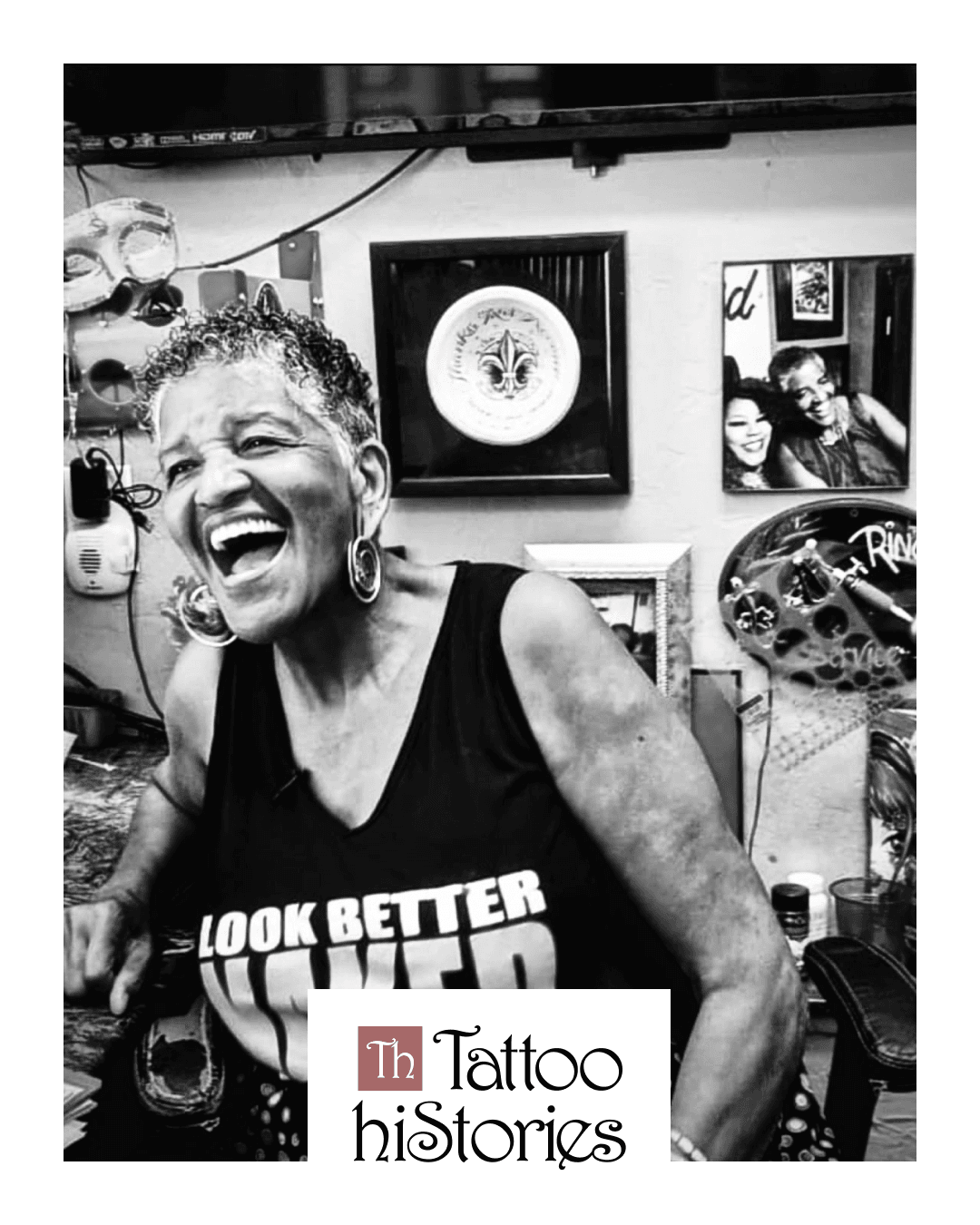Tattoo herStories | Jacci Gresham, 1st Black Female Tattoo Shop Owner in America

When tattoo artist Jacci Gresham opened her New Orleans shop nearly fifty years ago, there were less than half a dozen female tattoo artists in the U.S. and even fewer African-American artists.
From the Motor City to the Big Easy...
Originally from Flint, Michigan, Gresham moved to New Orleans from Detroit in 1976 after losing her engineering job at General Motors, where she drew plans and layouts for automobile dealerships before switching careers.
“General Motors had a big layoff in 1975. Ajit Singh and I decided to move to New Orleans. He was an Indian from England and knew tattooing. We both had worked at General Motors in Michigan. We opened this shop in ’76. Ajit died in ’99.” says Gresham. (01/31/2008 Interview w/Brobson Lutz, MD. My New Orleans)
That shop, Aart Accent Tattoos & Body Piercing in New Orleans, opened its doors in 1976 and is Louisiana’s oldest tattoo business still in operation. It’s also the first tattoo shop in the U.S. to ever be opened and owned by an African-American woman.
Setting Up Shop
“We started the shop in ‘76, right after Mardi Gras. It was a quarter of the size it is now. Just that front entrance, when you come in, that’s all there was. We had one main artist and I was learning to tattoo. Tattoos were pretty simple back then but I didn’t know how to do it at all. It wasn’t hard to learn. Tattoos were roses, hearts, eagles, banners, maybe a black panther, something like that. If you were doing a cover up, it was gonna be a reaper, more than likely, or a skull. Skulls aren’t as popular today. But that was all we used to do.” - Jacci Gresham (09/29/2020 Interview w/Sabrina Stone, Very Local New Orleans)
She explained in an earlier interview, “Ajit Singh taught me to tattoo right here in this room. At the time I was the only black female tattoo professional in the South. Back then women didn’t tattoo. Several artists work here, not just me.” (01/31/2008 Interview w/Brobson Lutz, MD. My New Orleans)
Breaking Down Barriers, Building Bridges...
Now 77-years old, Gresham has been tattooing for over four decades. Many consider her to be a “pioneer” of creating good art on black skin. Her presence in the tattoo trade not only makes it more accessible to minority and female artists, but also to the African-American community at large. Gresham not only broke into a male-dominated industry, but also a predominantly white one.
When Gresham began her tattooing career, it was difficult for people of colour to find artists who knew how to work on darker skin, and that was if shops allowed them in to begin with.
“Black people had tattoos in New Orleans, but most of the time they were hand-stuck,” Gresham recounts. “Part of the problem is, I think, the proprietors were unfriendly to us. When you went to a studio and this biker was sitting there, you could tell he wasn’t happy doing that.” - Jacci Gresham (04/17/2019 Interview with Tess Adamakos, Inked Magazine)
A Colourful Legacy
Jacci Gresham estimates that she’s tattooed thousands of people from all kinds of cultures – even a member of the Ku Klux Klan.
“It was interesting to talk to somebody from a Klan’s person that would allow a black person to tattoo them,” she said. “And the reason why he allowed me to tattoo him – or so he said – was because I gave a good tattoo.” - Jacci Gresham (02/24/2020 Interview with Kai Beech, Denver 7 News)
A good tattoo, Gresham believes, can help to break down racial barriers while inspiring younger artists at the same time.

"Black people should have been in tattooing a long time ago," Gresham said. "My professional accomplishment is to help other people learn the art of tattooing… and to perfect it." - Jacci Gresham (04/17/2019 Interview with Tess Adamakos, Inked Magazine)
To Learn More Check Out:
“Color Outside the Lines” - A documentary by Miya Bailey
“Lifers” Short Documentary on Jacci Gresham
Jacci Gresham on Instagram: @aartaccenttat2
DISCLAIMER: This story may contain copyrighted material which may not have been specifically authorized by the copyright owner. This material is available in an effort to educate our audience about notable figures in the industry. The material contained in this story is distributed without profit for research and educational purposes only. Only small portions of the original works are being used. This should constitute a “fair use” of any such copyrighted material (referenced and provided for in section 107 of the US Copyright Law.)
If you wish to use any copyrighted material from this story for purposes of your own that go beyond “fair use”, you must obtain expressed permission from the copyright owner.












